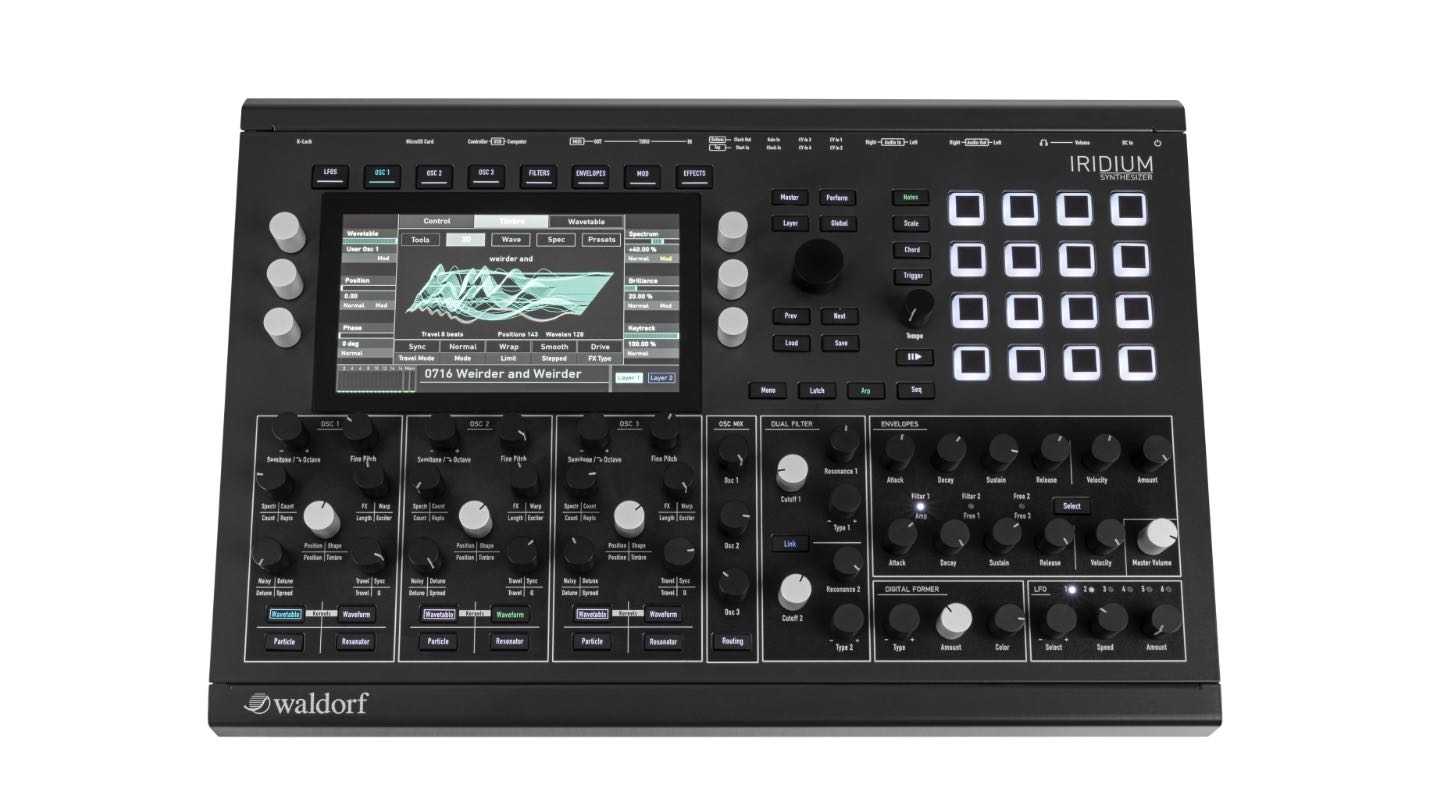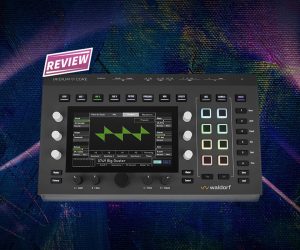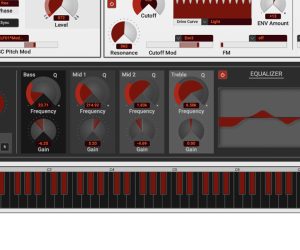
Waldorf Quantum Goes Desktop
Waldorf Music introduces its Iridium Synthesizer — sharing functionality and tonality with Quantum, packing and added extras into a desktop form factor.
Following in the Quantum Synthesizer’s footsteps, the Iridium Synthesizer features a generous high-resolution multitouch display working — with haptic feedback — in perfect harmony with an adroitly arranged control panel positioning all functions for speedy operation. Noticeably new to Iridium is its integrated 4 x 4 pad matrix, used to call up sequences, chords, scales, and arpeggios. A quick glance under the hood, however, reveals that the Iridium Synthesizer still shares the same selectable sound generation processes per oscillator (OSC 1, OSC 2, and OSC 3). As such, it can convincingly and comprehensively reproduce the sound spectra of the following five synthesis types: Wavetable, Waveform, Particle, Resonator, and Kernels.
As a direct descendant of the legendary PPG Wave hybrid digital/analogue synthesiser series that made their mark throughout the Eighties by bringing the distinctive sound of wavetable synthesis to the musical masses, the well-known Waldorf Music marque is synonymous with top-tier wavetable sounds. Subsequently refining and expanding this sound generation process’ potential, the sound of Waldorf wavetable oscillators span subtlety to brutality — animated, digital, and diverse, yet easy to control. Classic wavetables from well-known wavetable synthesizers hailing from the PPG and Waldorf stables, spectral analysis, speech synthesis, wavetable generation from audio material, and more besides are all available to Iridium Synthesizer users when selecting Wavetable.
With early wavetable synthesisers, even, typical waveforms familiar from analogue synthesisers were always available at the end of a wavetable. Waveform selection on Iridium goes far beyond this, though, by offering up to eight simultaneously selectable waveforms per oscillator, enabling infinitely dense, fat analogue-sounding tones, with detuned modes, tuneable noise, and hard sync.
2GB internal sample flash memory is available to the Iridium Synthesiser’s Particle oscillator, opening up possibilities of traditional stereo sampling with granular synthesis functionality — also available when processing a live input signal — for extensive manipulation of sample-based sounds. Along with the 2GB internal storage, sample material can be reloaded or backed up by the user via USB drives or MicroSD Card connections.
Creativity abounds further still when selecting the Resonator sound generation process to manipulate multi-samples from the internal sample flash memory or noise via an exciter and various modulatable spectral parameters — perfect for generating awe-inspiring animated sounds and drones, which can, for example, easily be integrated into a Eurorack modular synthesiser environment via the new integrated control voltage connections (CV In1, CV In2, CV In3, and CV In4).
Thanks to its innovative implementation of six Kernal operators, the Iridium Synthesiser can capably generate familiar FM (Frequency Modulation) tones of the type that revolutionised the entire synthesiser market in the early Eighties, as well as spectacularly different-sounding ones — and all without the notorious complexity associated with those once-revolutionary early-Eighties efforts ending up so overused on numerous hit records of the time. Thankfully, Iridium’s multitouch display supports the processing and visualisation of sonic relationships of its Kernels, considerably easing the process of creating spectacularly different-sounding tones with more than a touch of originality.
Better still, OSC 1, OSC 2, and OSC 3 can each play one of those sound generators, so spectacular-sounding sound design can come quickly to Iridium users of all levels — before being balanced by the Osc Mix (mixer). Thereafter, the signal from the three oscillators makes its way to the Dual Filter section where fully stereo multi-mode filters convincingly cover all conceivable classic filter variants. Various filter modes are additionally offered by the Digital Former, such as Comb, classic Waldorf high- and band-pass, and notch filters from Waldorf Music’s Largo and Nave software synthesizers, plus PPG models, alongside signal enhancer effects, such as Drive and Bit Crusher, and more.
Moreover, an LFO section with no fewer than six LFOs works with six loop-able Envelopes, all of which can be linked and smoothly operated within the 40-slot modulation matrix controllable via touchscreen.
With up to 16-voice polyphony in full stereo and an ability to overlay two sounds or play them simultaneously via the split function, the functional desktop design of Waldorf Music’s Iridium Synthesizer allows for sound design opportunities that are often out of this world with up to 7,000 patches internally saveable. Speaking of which, since Iridium Synthesiser patches are compatible with Waldorf Music’s flagship Quantum Synthesiser (running recently-released version 2.0 firmware), transfer between the two is possible. Such cross-compatibility means that the Iridium Synthesizer comes complete with an extremely extensive sound set from the get-go.
















RESPONSES